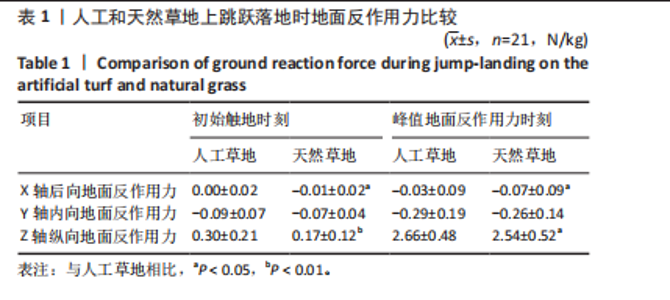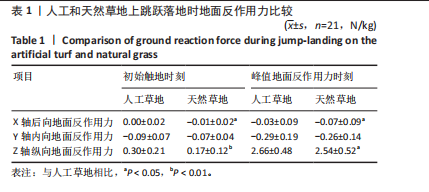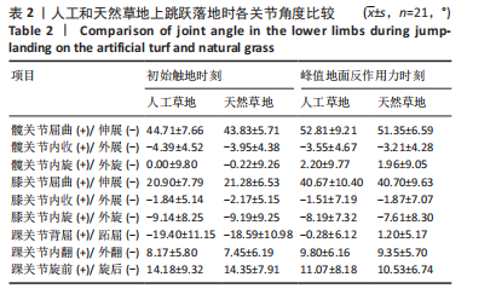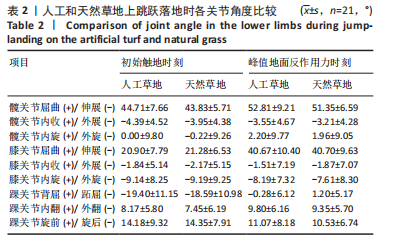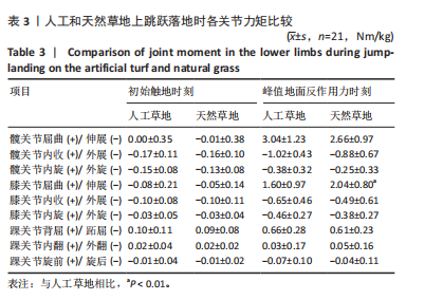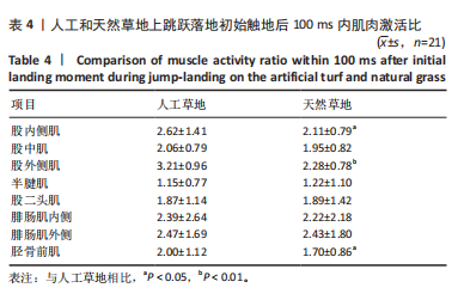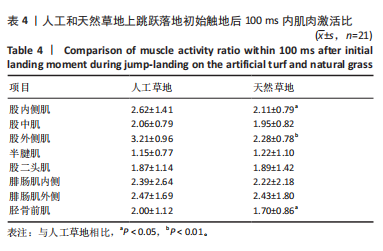Chinese Journal of Tissue Engineering Research ›› 2025, Vol. 29 ›› Issue (6): 1101-1107.doi: 10.12307/2025.270
Effects of artificial turf versus natural grass on biomechanical performance of the lower limbs in young females during jump-landing
Lu Jieming, Li Yajing, Du Peijie, Xu Dongqing
- Institute of Sport, Exercise and Health, Tianjin University of Sport, Tianjin 301617, China
-
Received:2024-02-08Accepted:2024-04-03Online:2025-02-28Published:2024-06-20 -
Contact:Xu Dongqing, PhD, Professor, Institute of Sport, Exercise and Health, Tianjin University of Sport, Tianjin 301617, China -
About author:Lu Jieming, Master, Assistant researcher, Institute of Sport, Exercise and Health, Tianjin University of Sport, Tianjin 301617, China -
Supported by:Graduate Student Research and Innovation Program of Tianjin, No. 2020YJSB103 (to LJM)
CLC Number:
Cite this article
Lu Jieming, Li Yajing, Du Peijie, Xu Dongqing. Effects of artificial turf versus natural grass on biomechanical performance of the lower limbs in young females during jump-landing[J]. Chinese Journal of Tissue Engineering Research, 2025, 29(6): 1101-1107.
share this article
Add to citation manager EndNote|Reference Manager|ProCite|BibTeX|RefWorks
| [1] DAI B, HERMAN D, LIU H, et al. Prevention of ACL injury, part I: injury characteristics, risk factors, and loading mechanism. Res Sports Med. 2012;20(3-4):180-197. [2] SHIMOKOCHI Y, SHULTZ SJ. Mechanisms of noncontact anterior cruciate ligament injury. Orthopedics. 2000;23(6):573-408. [3] PETERSON JR, KRABAK BJ. Anterior cruciate ligament injury: mechanisms of injury and strategies for injury prevention. Phys Med Rehabil Clin N Am. 2014;25(4):813-828. [4] LONGO UG, NAGAI K, SALVATORE G, et al. Epidemiology of anterior cruciate ligament reconstruction surgery in Italy: a 15-year nationwide registry study. J Clin Med. 2021;10(2):223. [5] GIANOTTI SM, MARSHALL SW, HUME PA , et al. Incidence of anterior cruciate ligament injury and other knee ligament injuries: a national population-based study. J Sci Med Sport. 2009;12(6):622-627. [6] CSINTALAN RP, INACIO MCS, FUNAHASHI TT. Incidence rate of anterior cruciate ligament reconstructions. Perm J. 2008;12(3):17-21. [7] HUGHES G, WATKINS J. A risk-factor model for anterior cruciate ligament injury. Sports Med. 2006;36(5):411-428. [8] LAIBLE C, SHERMAN OH. Risk factors and prevention strategies of non-contact anterior cruciate ligament injuries.Bull Hosp Jt Dis (2013). 2014;72(1):70-75. [9] HEWETT TE, MYER GD, FORD KR, et al. Mechanisms, prediction, and prevention of ACL injuries: Cut risk with three sharpened and validated tools. J Orthop Res. 2016;34(11):1843-1855. [10] WONG TL, HUANG CF, CHEN PC. Effects of lower extremity muscle fatigue on knee loading during a forward drop jump to a vertical jump in female athletes. J Hum Kinet. 2020:72:5-13. [11] AUGUSTSSON J, THOMEÉ R, LINDÉN C, et al. Single-leg hop testing following fatiguing exercise: reliability and biomechanical analysis.Scand J Med Sci Sports. 2006;16(2):111-120. [12] WILLIAMS JH, AKOGYREM E, WILLIAMS JR. A Meta-Analysis of Soccer Injuries on Artificial Turf and Natural Grass.J Sports Med (Hindawi Publ Corp). 2013;2013:380523. [13] DRAKOS MC, HILLSTROM H, VOOS JE, et al. The effect of the shoe-surface interface in the development of anterior cruciate ligament strain.J Biomech Eng. 2010;132(1):011003. [14] EKSTRAND J, HAGGLUND M, FULLER CW. Comparison of injuries sustained on artificial turf and grass by male and female elite football players. Scand J Med Sci Sports. 2011;21(6):824-832. [15] XIAO M, LEMOS JL, HWANG CE, et al. Increased Risk of ACL Injury for Female but Not Male Soccer Players on Artificial Turf Versus Natural Grass: A Systematic Review and Meta-Analysis. Orthop J Sports Med. 2022;10(8):23259671221114353. [16] BALAZS GC, PAVEY GJ, BRELIN AM, et al. Risk of Anterior Cruciate Ligament Injury in Athletes on Synthetic Playing Surfaces: A Systematic Review. Am J Sports Med. 2015;43(7):1798-804. [17] NGATUVAI MS, YANG J, KISTAMGARI S, et al. Epidemiological Comparison of ACL Injuries on Different Playing Surfaces in High School Football and Soccer. Orthop J Sports Med. 2022;10(5): 23259671221092321. [18] HOWARD M, SOLARU S, KANG HP, et al. Epidemiology of Anterior Cruciate Ligament Injury on Natural Grass Versus Artificial Turf in Soccer: 10-Year Data From the National Collegiate Athletic Association Injury Surveillance System. Orthop J Sports Med. 2020;8(7): 2325967120934434. [19] CARD RK, HARRINGTON JM, REYES NP, et al. Does playing surface affect the risk of anterior cruciate ligament injuries in the National Football League? A look at the 2017 - 2021 NFL seasons. Phys Sportsmed. 2024;52(1):98-101. [20] CRUZ A, BELL D, MCGRATH M, et al. The effects of three jump landing tasks on kinetic and kinematic measures: implications for ACL injury research. Res Sports Med. 2013;21(4):330-342. [21] DAI B, COOK RF, MEYER EA, et al. The effect of a secondary cognitive task on landing mechanics and jump performance. Sports Biomech. 2018;17(2):192-205. [22] 周星栋,肖丹丹,郭文霞,等.乒乓球运动员膝关节损伤机制研究——对3种常用步法的膝关节负荷特征分析[J].中国体育科技, 2020,56(6):62-67. [23] 周志鹏,郑亮亮,孙萌梓,等.鞋帮高度对踝关节不稳者侧切动作下肢生物力学特征的影响[J].中国运动医学杂志,2021,40(5):352-359. [24] DAI B, HEINBAUGH EM, NING X, et al. A resistance band increased internal hip abduction moments and gluteus medius activation during pre-landing and early-landing. J Biomech. 2014;47(15):3674-3680. [25] POULOS CC, GALLUCCI J, GAGE WH, et al. The perceptions of professional soccer players on the risk of injury from competition and training on natural grass and 3rd generation artificial turf. BMC Sports Sci Med Rehabil. 2014;6(1):11 [26] LEE SY, CHOU CY, HOU YY, et al. The effects of changes in step width on plantar foot pressure patterns of young female subjects during walking.J Mech Med Biolo. 2011;11(5):1071-1083. [27] HASHEMI J, BREIGHNER R, CHANDRASHEKAR N, et al. Hip extension, knee flexion paradox: A new mechanism for non-contact ACL injury. J Biomech. 2011;44(4):577-585. [28] YU B, LIN CF, GARRETT WE. Lower extremity biomechanics during the landing of a stop-jump task. Clin Biomech (Bristol, Avon). 2006; 21(3):297-305. [29] GUENTHER D, RAHNEMAI-AZAR AA, FU FH, et al. The biomechanical function of the anterolateral ligament of the knee: Letter to the editor.Am J Sports Med. 2015;43(8):NP21-NP22. [30] CERULLI G , BENOIT DL , LAMONTAGNE M , et al. In vivo anterior cruciate ligament strain behaviour during a rapid deceleration movement: case report. Knee Surg Sports Traumatol Arthrosc. 2003; 11(5):307-311. [31] LAMONTAGNE M, BENOIT DL, RAMSEY DK, et al. What can we learn from in vivo biomechanical investigations of lower extremity? International Conference on International Conference on Orthopaedics, Biomechanics. 2008. [32] KOGA H, NAKAMAE A, SHIMA Y, et al. Mechanisms for noncontact anterior cruciate ligament injuries: knee joint kinematics in 10 injury situations from female team handball and basketball. Am J Sports Med. 2010;38(11):2218-2225. [33] 赵虎,霍洪峰.跑步运动中下肢刚度的应用与研究进展[J].中国体育科技,2022,58(10):63-71. [34] 王爱文,罗冬梅.人体运动控制理论及计算模型的研究进展[J].体育科学,2017,37(8):58-68. [35] 周成林,赵洪朋,张怡.运动领域中的认知神经心理学研究进展[J].天津体育学院学报,2012,27(3):197-201. [36] COLBY S, FRANCISCO A, YU B, et al. Electromyographic and kinematic analysis of cutting maneuvers. Implications for anterior cruciate ligament injury. Am J Sports Med. 2000;28(2):234-240. [37] CHAPPELL JD, CREIGHTON RA, GIULIANI C, et al. Kinematics and electromyography of landing preparation in vertical stop-jump: risks for noncontact anterior cruciate ligament injury. Am J Sports Med. 2007;35(2):235-241. [38] STRUTZENBERGER G, CAO HM, KOUSSEV J, et al. Effect of turf on the cutting movement of female football players. J Sport Health Sci. 2014;3(4):314-319. [39] 杨辰,曲峰,万祥林,等. 不同牵引力人造草坪对男子足球运动员急停起跳膝关节前交叉韧带损伤的影响[J]. 天津体育学院学报, 2017,32(4):350-354. [40] ALMONROEDER TG, KERNOZEK T, COBB S, et al. Divided attention during cutting influences lower extremity mechanics in female athletes. Sports Biomech. 2019;18(3):264-276. [41] ALMONROEDER TG, KERNOZEK T, COBB S, et al. Cognitive demands influence lower extremity mechanics during a drop vertical jump task in female athletes. J Orthop Sports Phys Ther. 2018;48(5):381-387. |
| [1] | Zhong Caihong, Xiao Xiaoge, Li Ming, Lin Jianhong, Hong Jing. Biomechanical mechanism of sports-related patellar tendinitis [J]. Chinese Journal of Tissue Engineering Research, 2026, 30(6): 1417-1423. |
| [2] | Yu Xinlin, Chen Huiyu, Wang Yingying, Guo Weizhong, Feng Bin Lin Chengshou, Lin Wang. Finite element analysis of internal fixation with new retrograde intramedullary nail on lateral femur condyle for distal type A2 femur fractures [J]. Chinese Journal of Tissue Engineering Research, 2026, 30(3): 546-552. |
| [3] | Zhao Jingang, Liu Liping, Chen Jianwei, . Finite element analysis comparing lumbar fusion and artificial intervertebral disc replacement [J]. Chinese Journal of Tissue Engineering Research, 2026, 30(3): 553-560. |
| [4] | Ma Jingbo, Yang Guangnan, Liu Jiang, Jiang Qiang, Zhang Hanshuo, Han Jiaheng, Ding Yu. Endoscopic lumbar canal decompression for upper lumbar spinal stenosis: a comparison of biomechanical stability of three surgical models [J]. Chinese Journal of Tissue Engineering Research, 2026, 30(3): 577-585. |
| [5] | Abudusalamu·Tuoheti, Xiao Yang, Wang Yixi, Musitapa·Mijiti, Chen Qihao, Maimaitiming·Saiyiti, Guo Hailong, Paerhati·Rexiti. Effects of three internal fixation techniques on biomechanics of adjacent segment degeneration in lumbar interbody fusion [J]. Chinese Journal of Tissue Engineering Research, 2026, 30(3): 586-595. |
| [6] | Shang Depeng, Wei Haiyu, Yang Fan. Finite element analysis for three different types of internal screw fixation in treatment of severe lumbar 1 vertebral body fractures [J]. Chinese Journal of Tissue Engineering Research, 2026, 30(3): 537-545. |
| [7] | Kang Zirui, Wu Yang, Song Hailong, Yang Qiaoyun, Zang Lixiang, Xu Dongliang. Finite element analysis of implants with different crown-to-implant ratios under different bone conditions [J]. Chinese Journal of Tissue Engineering Research, 2026, 30(2): 319-328. |
| [8] | Sun Xiaojun, Wang Huaming, Zhang Dehong, Song Xuewen, Huang Jin, Zhang Chen, Pei Shengtai. Effect of finite element method in treatment of developmental dysplasia of the hip in children [J]. Chinese Journal of Tissue Engineering Research, 2025, 29(9): 1897-1904. |
| [9] | Li Liangkui, Huang Yongcan, Wang Peng, Yu Binsheng. Effect of anterior controllable anteriodisplacement and fusion on vertebrae-ossification of posterior longitudinal ligament complex and implants: a finite element analysis [J]. Chinese Journal of Tissue Engineering Research, 2025, 29(9): 1761-1767. |
| [10] | Xu Biao, Lu Tan, Jiang Yaqiong, Yin Yujiao. Xu Biao, Lu Tan, Jiang Yaqiong, Yin Yujiao [J]. Chinese Journal of Tissue Engineering Research, 2025, 29(9): 1768-1774. |
| [11] | Zhou Jinhai, Li Jiangwei, Wang Xuquan, Zhuang Ying, Zhao Ying, Yang Yuyong, Wang Jiajia, Yang Yang, Zhou Shilian. Three-dimensional finite element analysis of anterior femoral notching during total knee arthroplasty at different bone strengths [J]. Chinese Journal of Tissue Engineering Research, 2025, 29(9): 1775-1782. |
| [12] | Fu Enhong, Yang Hang, Liang Cheng, Zhang Xiaogang, Zhang Yali, Jin Zhongmin. OpenSim-based prediction of lower-limb biomechanical behavior in adolescents with plantarflexor weakness [J]. Chinese Journal of Tissue Engineering Research, 2025, 29(9): 1789-1795. |
| [13] | Yang Yicheng, Zheng Zhizhen, Liang Shuangxue, Wu Chengliang, Du Yunyun. Influence and implications of basketball shoes' functional parameters on human biomechanics [J]. Chinese Journal of Tissue Engineering Research, 2025, 29(35): 7620-7628. |
| [14] | Wang Lei, Li Chengsong, Zhang Shenshen, Wang Qing. Finite element analysis of biomechanical characteristics of three internal fixation methods in treatment of inferior patellar fracture [J]. Chinese Journal of Tissue Engineering Research, 2025, 29(33): 7048-7054. |
| [15] | Xu Xin, Wurikaixi·Aiyiti, Lyu Gang, Maimaiaili·Yushan, Ma Zhiqiang, Ma Chao. Finite element analysis of four different internal fixation methods for complex acetabular double-column fractures [J]. Chinese Journal of Tissue Engineering Research, 2025, 29(33): 7063-7071. |
| Viewed | ||||||
|
Full text |
|
|||||
|
Abstract |
|
|||||
